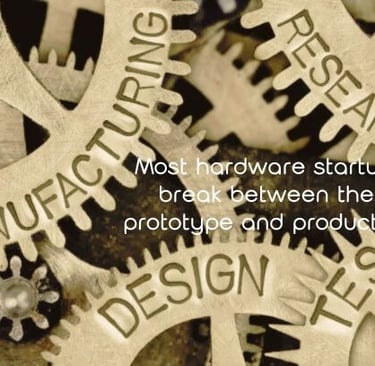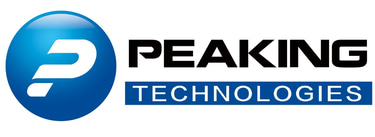Why Design for Manufacturability is Critical for Hardware Startups
As a manufacturing partner, we’ve seen countless hardware startups come through our doors with big dreams, promising prototypes, and a vision to disrupt markets. Yet, the harsh reality is that many of these ventures stumble—not because their ideas lack merit, but because they fail to bridge the gap between prototype and production.
5/11/20254 min read


As a manufacturing partner, we’ve seen countless hardware startups come through our doors with big dreams, promising prototypes, and a vision to disrupt markets. Yet, the harsh reality is that many of these ventures stumble—not because their ideas lack merit, but because they fail to bridge the gap between prototype and production. The key to surviving this transition? Design for Manufacturability (DFM). If you’re a hardware startup with $1.2M in funding, DFM isn’t just a buzzword—it’s your lifeline to avoid burning through your runway. Here’s why designing for the factory floor from day one is non-negotiable and how it can make or break your journey to market.
The Prototype-to-Production Trap
Most hardware startups pour their hearts into crafting a prototype that wows investors and validates their concept. These prototypes often look sleek, function beautifully in controlled environments, and spark excitement. But here’s the catch: a prototype that shines in a lab can crumble on the factory floor. We’ve seen it time and again—designs that rely on exotic materials, overengineered enclosures, or intricate assemblies that seem flawless until they hit production. Suddenly, you’re facing wrong materials, assembly bottlenecks, or components that can’t be sourced at scale.
The lesson? A prototype is not a product. It’s a proof of concept that needs to evolve with manufacturing in mind. By embracing DFM from the outset, you ensure your design is robust, scalable, and ready for the realities of production. This approach saves time, money, and heartache by catching issues early—before they become expensive problems.
Build with the Factory from Day One
One of the biggest mistakes startups make is treating manufacturing as an afterthought. They design in isolation, assuming the factory will “figure it out.” This is a recipe for disaster. As a contract manufacturer, we can tell you that the best products are co-designed with the factory from the start. Why? Because the factory floor has its own rules. A junior operator assembling your product on a noisy line, after a long shift, needs a design that’s intuitive, forgiving, and fast—think three-minute assembly, blindfolded.
By involving your manufacturing partner early, you gain insights into material choices, assembly processes, and cost drivers. For example, we’ve seen startups design enclosures with tight tolerances that look stunning but are a nightmare to assemble consistently. A simple tweak—widening a tolerance or simplifying a snap-fit—can slash production time and defects. Weekly check-ins, yield data, and quality feedback from your manufacturer aren’t just nice-to-haves; they’re your roadmap to a scalable product. Build with us, not against us, and you’ll avoid costly redesigns when scaling.
Treat Your BOM Like a Minefield
Your Bill of Materials (BOM) is the backbone of your product, and every component is a potential point of failure. Single-source parts, end-of-life components, or volatile pricing can derail your production faster than you can say “supply chain crisis.” As a manufacturer, we urge startups to audit their BOM with paranoia. Ask yourself: Can I replace this part easily? Is it available from multiple suppliers? Are lead times reasonable? If the answer is no, swap it out.
Boring, off-the-shelf components might not impress your engineering team, but they ship product. Exotic parts, while tempting, introduce risks that can halt production or inflate costs. We’ve seen startups scramble when a niche sensor became unavailable, forcing a redesign mid-production. A DFM-focused approach prioritizes resilience, ensuring your BOM is robust and adaptable to supply chain realities.
Build Ugly to Reveal Truth
It’s tempting to chase a polished, market-ready design early on. But sleek enclosures and refined aesthetics can hide flaws—flaws that only surface during shipping, thermal stress, or fatigue testing. As a factory, we advocate for starting with an “ugly” build: raw, functional, with exposed wires, 3D-printed parts, and off-the-shelf components. This version tells the truth about your product’s weaknesses.
An ugly build lets you test real-world conditions—vibration, heat, drops—without the veneer of a pretty exterior. It’s easier to fix a failing connector or reinforce a weak joint now than to recall thousands of units post-launch. DFM means prioritizing function over form in the early stages, so you can iterate fast and scale confidently.
Obsess Over Margin from the Start
Margin isn’t just a financial metric; it’s a survival metric. As a manufacturer, we see startups underestimate the true cost of production—tooling, labor, defects, and logistics all add up. If your $250 product costs $90 to make, you’re already on thin ice. A DFM mindset designs for margin from day one, targeting at least a 4x markup on production costs before tooling. This means choosing cost-effective materials, simplifying assemblies, and minimizing waste.
You can’t “fix” margin later. Every design decision—from the number of screws to the type of finish—impacts your cost structure. Work with your manufacturer to identify cost drivers early, and make trade-offs that preserve profitability without compromising quality.
Your Manufacturer as Your Co-Strategist
A contract manufacturer isn’t just a vendor; we’re your partner in scaling. The startups that thrive treat us like co-strategists, keeping us in the loop with regular updates and collaborative problem-solving. When you go quiet, we’re forced to guess—and guesses lead to mistakes. Share your design iterations, ask for our input, and leverage our expertise in yield optimization and quality control. Together, we can catch issues before they spiral, ensuring a smooth transition to high-volume production.
Build Slow, Learn Fast, Scale Lean
The path from prototype to production is fraught with pitfalls, but DFM is your guide. By designing for the factory, auditing your BOM, building ugly, obsessing over margin, and partnering closely with your manufacturer, you maximize your $1.2M runway and set yourself up for success. Hardware is hard, but it’s not impossible. Build slow to learn fast, and you’ll scale lean—delivering a product that’s not just innovative, but manufacturable, reliable, and profitable.
Let’s work together to turn your vision into reality, one well
